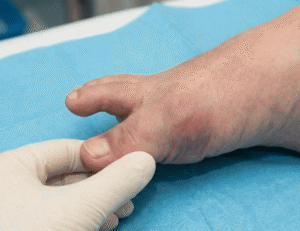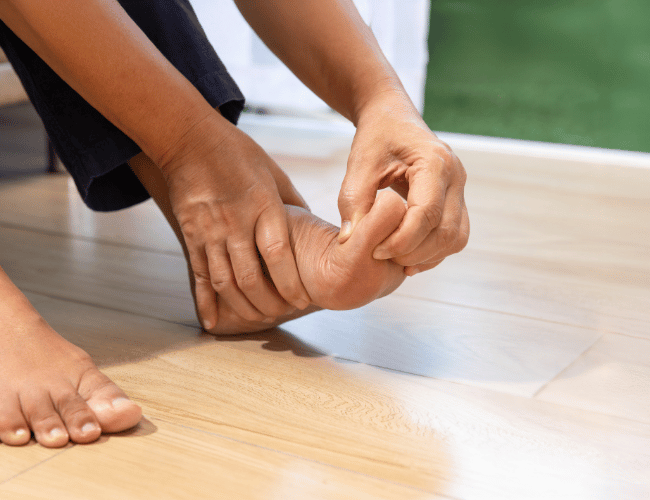
Dislocated Big Toe Treatment: What You Need to Know
Dislocating your big toe may not sound like a serious injury until it happens. At SFL Medical Group, we’ve seen firsthand how even a seemingly

Foot pain can be caused by many things from plantar fasciitis to nerve entrapment but one often overlooked culprit is bursitis. This relatively common condition affects the bursae, small fluid-filled sacs found throughout our bodies, including several in the feet. When these sacs become irritated or inflamed, even basic movements like walking can become painful.
We often see patients at SFL Medical Group coming in after weeks or months of discomfort, unaware that the very issue causing so much distress was subtle inflammation all along. That’s why understanding bursitis in the foot and knowing how to properly treat it is crucial for long-term joint health and mobility.
Bursae act like natural cushions placed between bones, tendons, and muscles. They reduce friction in areas where movement occurs frequently. The foot alone contains several bursae around the heel, the big toe joint, and the underside of the foot near the metatarsal heads.
Similar to how brake pads wear out over time, bursae can become inflamed after repetitive motion, excessive pressure, or in response to trauma. When this occurs, it leads to a condition we know as bursitis.
There isn’t always one clear cause, but several contributing factors can lead to the development of foot bursitis. At SFL Medical Group, we help patients identify these triggers through personalized assessments.
Runners, dancers, and athletes are especially prone to bursitis due to continuous foot movement. Even occupations requiring long periods of standing can stress the bursae.
Shoes that are too tight, lack arch support, or place excess pressure on specific areas of the foot can irritate bursae. High heels are especially notorious for triggering bursitis at the forefoot or under the toes.
One-off impacts like dropping a heavy object on your foot or twisting it can inflame bursae and initiate a pain cycle.
Conditions like rheumatoid arthritis, gout, or diabetes increase the likelihood of foot bursitis due to systemic inflammation, poor circulation, or altered foot mechanics.
Not all foot bursitis cases are the same. Depending on the location of the inflamed bursa, the symptoms and recommended treatments will vary.
Located behind the heel, this is one of the most talked-about types. It often affects those who wear rigid-heeled shoes or suffer from Achilles tendon overuse.
This occurs between the metatarsal bones in the forefoot and usually feels like walking on pebbles. It’s most common in people with high-impact lifestyles or poor footwear choices.
Present around the base of the big toe, this form often develops alongside bunions. The bursa near the bony bump becomes irritated due to pressure and misalignment.
Bursitis in the foot tends to sneak up. In the beginning, the discomfort may feel like harmless tightness or pressure. For many, symptoms fluctuate but overuse, continued pressure, or improper footwear can escalate the condition.
Signs to watch for:
When caught early, these symptoms are highly treatable. But, as we always tell our patients, waiting too long increases the risk of chronic pain or secondary complications like tendonitis.
Our podiatry specialists start by analyzing your pain history, footwear, and daily activities. Physical exams often involve identifying tender pressure points and assessing joint movement.
When necessary, imaging tools such as X-rays or ultrasound help us rule out fractures, ligament injuries, or soft tissue damage. In certain cases, MRI scans confirm soft tissue inflammation in deeper bursae.
At SFL Medical Group, we don’t just treat symptoms, we get to the root cause using a multidisciplinary approach customized for each case.
Treating bursitis of the foot often requires a combination of rest, physical therapy, and lifestyle adjustments. The good news? Most cases resolve without invasive surgery.
Many cases improve with the following steps:
We might recommend targeted stretching and strengthening routines to reduce strain on inflamed areas.
Therapeutic modalities like ultrasound therapy or electrical stimulation can also reduce inflammation and promote circulation.
If pain is persistent, a corticosteroid injection may calm inflammation. These injections are typically administered under image guidance to ensure precision.
Only in chronic cases that resist other treatments do we consider surgical intervention. Surgery might involve draining the bursa or removing it entirely, which is safe and often provides lasting relief.
Managing foot bursitis doesn’t end with symptom relief. We emphasize long-term prevention just as much as treatment.
Here’s what we often recommend:
If foot pain doesn’t improve with basic care or starts interfering with your daily routine, don’t tough it out alone. Early intervention can mean the difference between a few weeks of discomfort and chronic pain that affects your quality of life.
At SFL Medical Group, we bring together orthopedic specialists, podiatrists, and rehabilitation professionals to treat foot bursitis with precision and compassion. Whether you need a comprehensive diagnosis or expert-guided therapy, we’re here to help you walk comfortably again.
More To Explore

Dislocating your big toe may not sound like a serious injury until it happens. At SFL Medical Group, we’ve seen firsthand how even a seemingly

What Is Acute Arterial Occlusion and Why It Should Be Treated Urgently When an artery suddenly becomes blocked, cutting off blood supply to an organ

©2025 South Florida Multispecialty Medical Group. All Rights Reserved.